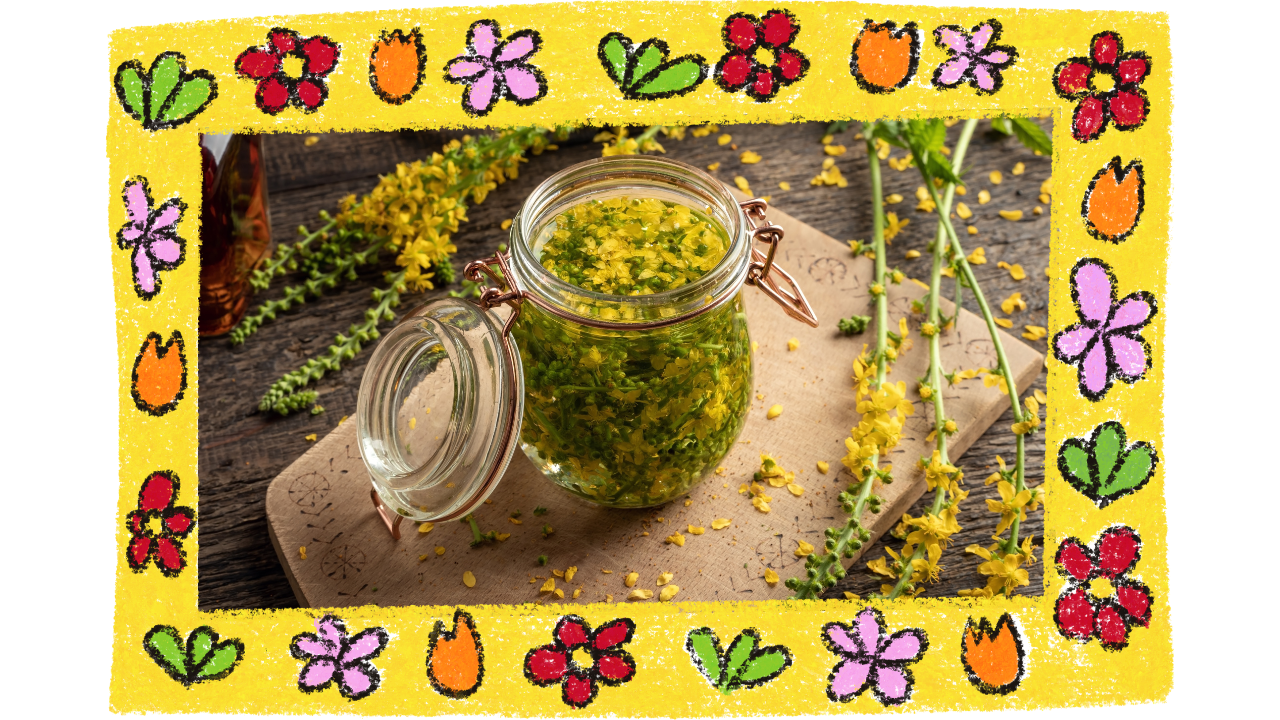Herbs | Last Modified:
Unlocking the Healing Potential of Agrimony: Benefits, Uses, and Preparations

What is Agrimony?
Agrimony (Agrimonia eupatoria), a member of the Rosaceae family, is a versatile herb historically known for its medicinal properties. Its aerial parts are rich in beneficial compounds, including tannins, coumarins, flavonoids (such as luteolin), volatile oils, and polysaccharides. This potent combination gives agrimony its astringent, tonic, and diuretic properties, among other healing actions like acting as a vulnerary, antispasmodic, and carminative. Steeped in history, the name "Eupatoria" honors King Mithridates Eupator, a renowned ancient ruler known for his profound knowledge of plant remedies and antidotes to poisons.
Where Agrimony Grows and How It’s Cultivated
Agrimony (Agrimonia eupatoria) is an erect, downy perennial that typically reaches heights of up to 3 feet (1 meter). Characterized by its paired, green leaves with silvery-green undersides and small, terminal spikes of yellow, five-petaled flowers, this herb thrives in its native habitats of marshes, wet meadows, and open areas across middle and northern Europe, temperate Asia, and North America.
Agrimony is harvested during the summer when it is in full bloom, with the aboveground parts collected just before or during flowering. The cultivation process involves cutting the flowering plant a few inches above the ground, followed by drying to prepare it for effective medicinal use. Its distinctive flowering spikes, featuring rough-haired calyxes and thorny fruits, further enhance its unique botanical profile.
Benefits and Uses of Agrimony Herb
Medicinal Actions
Agrimony has been a trusted remedy in herbal medicine for centuries, known primarily for its ability to staunch bleeding and promote clot formation, making it an effective healer for wounds. Its astringent properties also aid in treating diarrhea and serve as a gentle tonic for overall digestion.
Urinary and Kidney Health
This herb is particularly beneficial for urinary health. When combined with other herbs, such as cornsilk, agrimony is a valuable remedy for conditions like cystitis and urinary incontinence. It has also been traditionally used for kidney stones and related discomfort.
Anti-Inflammatory Properties
Research, particularly from studies in China, has highlighted agrimony's blood-staunching and anti-inflammatory effects. These properties make it useful for soothing sore throats, addressing hoarseness, and managing symptoms of rheumatism and osteoarthritis.
Indications and Approved Uses
Agrimony is recognized by the Commission E for several indications, including:
- Diarrhea
- Skin inflammation
- Inflammation of the mouth and pharynx
Additional Applications
While its primary uses are well-established, agrimony has unproven applications that include:
- Mild, nonspecific acute diarrhea
- Inflammation of kidney and bladder
- Diabetes and childhood bedwetting
- Poorly healing wounds and chronic pharyngitis
In Chinese medicine, agrimony is utilized not only as a hemostyptic but also for certain forms of cancer and as an anthelmintic.
Gentle and Safe for Children
One of the appealing aspects of agrimony is its gentle nature, making it suitable for children, thereby expanding its accessibility as a natural remedy.
Agrimony Herb Preparations and Dosage Guidelines
Safety Considerations
Agrimony is generally regarded as safe, with no reported side effects or drug interactions when used at designated therapeutic dosages. However, due to its tannin content, excessive intake may lead to digestive complaints or constipation.
Preparations
1. Tincture:
- Recommended dosage is 1 to 4 ml three times a day (1:5 in 45% alcohol).
2. Infusion:
- For an infusion, pour 1 cup of boiling water over 1 to 2 teaspoons of dried agrimony. Allow it to infuse for 10 to 15 minutes, and consume three times daily.
3. Decoction:
- A decoction can be prepared using 1 dram (approximately 4 g) of pulverized leaves. This method is also supported by Ellingwood.
4. Poultice:
- For external use, a poultice made from a 10% decoction can be applied several times a day.
Dosage Guidelines
-
Internal Use: The average daily dosage ranges from 3 to 6 g of the herb or equivalent preparations. Specific recommendations include:
- 1 to 1.5 g (BIS)
- 2 to 4 g, three times daily (CAN)
- 3 g of herb (KOM; PHR)
-
External Use: For topical applications, use a poultice prepared from a decoction of agrimony several times a day.
Additional Notes
- The United States Dispensatory suggests a dosage of 1 dram (4 g) or more.
- For liquid herb extracts, dosages range from 2 to 4 ml or 1 to 3 ml of a 1:1 extract in 25% ethanol, taken three times a day.
Always consult with a healthcare professional before starting any new herbal regimen to ensure safety and effectiveness.
Closing Remarks
Thank you for joining us on this exploration of Agrimony (Agrimonia eupatoria) and its remarkable benefits! From its potent astringent properties to its supportive role in digestive health and wound healing, we hope this guide has provided valuable insights into this versatile herb. As you continue your journey toward holistic wellness, stay tuned for more informative articles on traditional herbs and their time-honored applications in natural healing.
